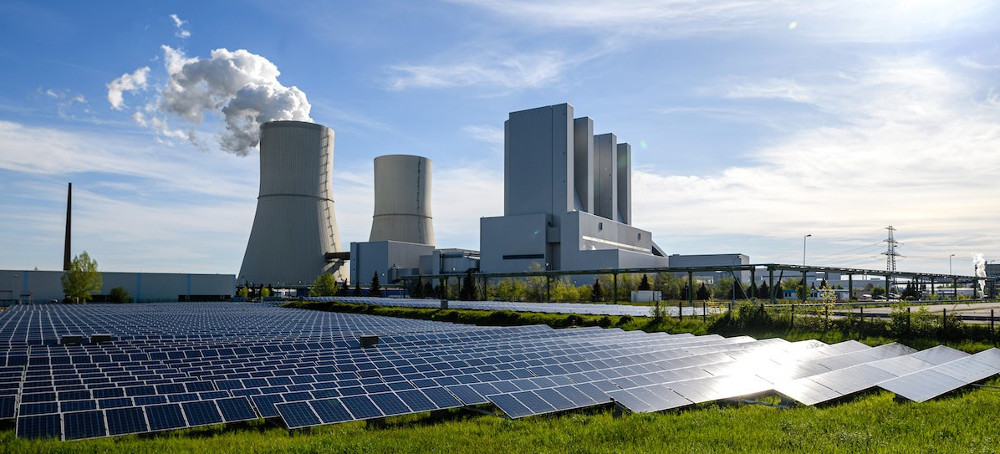'Clean Energy Is Moving Fast': Investments in Renewables Will Overtake Fossil Fuels for the First Time This Year, IEA Says
Cristen Hemingway Jaynes EcoWatch A solar energy field next to the Lippendorf coal-fired power plant in Lippendorf, Germany. (photo: Jens Schlueter/EPA)
A solar energy field next to the Lippendorf coal-fired power plant in Lippendorf, Germany. (photo: Jens Schlueter/EPA) 'Clean Energy Is Moving Fast': Investments in Renewables Will Overtake Fossil Fuels for the First Time This Year, IEA Says
Cristen Hemingway Jaynes EcoWatchAccording to the World Energy Investment report, the global energy crisis that followed Russia’s invasion of Ukraine, as well as the growing affordability of renewables, has given rise to more sustainable alternatives, sparking a rise in investments.
“Clean energy is moving fast – faster than many people realise. This is clear in the investment trends, where clean technologies are pulling away from fossil fuels,” said IEA Executive Director Fatih Birol in an IEA press release. “For every dollar invested in fossil fuels, about 1.7 dollars are now going into clean energy. Five years ago, this ratio was one-to-one. One shining example is investment in solar, which is set to overtake the amount of investment going into oil production for the first time.”
In 2023, approximately $2.8 trillion will be invested in energy globally, the report said. More than $1.7 trillion of that amount is projected to be invested in green energy technologies like electric vehicles (EVs), renewables, power grids, nuclear energy, heat pumps, low-emissions fuels and improvements in energy efficiency. The remaining more than $1 trillion will be invested in gas, oil and coal.
Yearly investments in renewables are predicted to increase by 24 percent from 2021 to 2023, while fossil fuel investments are expected to rise just 15 percent. Advanced economies, as well as China, are responsible for more than 90 percent of the growth, which could jeopardize global energy equality if green energy investment increases aren’t seen in other parts of the world.
“Weak grid infrastructure is a limiting factor for renewable investment in many developing economies, and here too current investment flows are highly concentrated. Advanced economies and China account for 80% of global spending and for almost all of the growth in recent years,” the report said.
Renewable energy technologies are projected to make up nearly 90 percent of power generation investment this year, led by solar energy.
Investments in solar are expected to reach more than $1 billion per day this year, for a total of $382 billion in 2023, reported Reuters. Oil production investment is projected to be $371 billion.
“This crowns solar as a true energy superpower. It is emerging as the biggest tool we have for rapid decarbonisation of the entire economy,” said Dave Jones, energy think tank Ember’s head of data insights, as Reuters reported.
EV sales are projected to rise by one-third in 2023, following a jump last year, the press release said. Since 2021, sales of heat pumps worldwide have also grown by double digits.
New initiatives like the U.S. Inflation Reduction Act and policies in Europe, China, Japan and other countries, as well as phases of vigorous economic growth coupled with unstable fossil fuel prices have helped prompt investments in clean energy.
Oil and gas upstream spending is projected to increase by seven percent this year, primarily by large Middle Eastern national oil companies.
New fossil fuel investments will increase by six percent to $950 billion this year, according to the IEA report.
The increase in fossil fuel investments will lead to levels this year that are more than twice where they need to be in 2030 to be on track for the Net Zero Emissions by 2050 Scenario laid out by the IEA, the press release said.
Last year, demand for coal was at a record high. In 2023, investment in coal is on a trajectory for a six-fold increase over the levels forecast to reach net zero goals for 2030.
“Investment in coal supply is expected to rise by 10% in 2023, and is already well above pre-pandemic levels. Investment in new coal-fired power plants remains on a declining trend, but a warning sign came in 2022 with 40 GW of new coal plants being approved – the highest figure since 2016,” the report said.
The largest green energy investment deficiencies were found to be in developing and emerging nations. Higher interest rates, weak grid infrastructure, high capital costs, obscure policy rules and strained utilities have hampered investments in renewables in those countries.
“The irony remains that some of the sunniest places in the world have the lowest levels of solar investment,” Jones said, as reported by Reuters.
